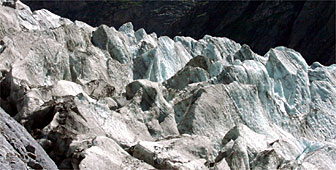Glaciers head towards meltdown

Glaciers are icy time capsules, storing evidence of change to the earth's atmosphere over millennia. And the great retreat of alpine glaciers in the past 150 years shows that the earth is getting warmer. Scientists have predicted that these frozen laboratories will disappear if temperatures continue to rise, and warn of severe consequences for alpine countries.
The Aletsch, the longest glacier in the Alps, isn’t what it used to be. Measuring nearly 27 kilometres in length about 150 years ago, it has since receded about three kilometres and lost about 20 per cent of its surface area.
In the 18th and 19th centuries, the Lower Grindelwald Glacier attracted scholars, painters and poets. Today, a deep two-kilometre gorge cut by the receding ice mass is all that is left of the advance.
Scientists at the University of Zurich have documented periods of recession and advances that have taken place over thousands of years. For the past 500 years, they have used historical records and landscape paintings to form a relatively accurate picture of glacial activity.
To understand the prehistoric movement of glaciers, they have relied on radiocarbon dating of fossil wood and soil elements found in or near glaciers.
Their research also provides invaluable clues to climate change. By drilling under the surface, researchers find traces of once-airborne chemicals and precipitation trapped in the frozen layers.
Chernobyl particles
Radioactive particles from the Chernobyl nuclear disaster were found in the glaciers around Mont Blanc, showing how glaciers preserve history, and more troubling, how susceptible the alpine climate is to events thousands of kilometres away.
Examining ice samples extracted from far below the surface of the Antarctic, scientists have uncovered evidence of changes to the earth’s atmosphere dating back 20,000 years.
An expert at the University of Zurich, Hans-Peter Holzhauser, says that because glaciers are highly sensitive to changes to the “energy balance at the earth’s surface” they can help in devising strategies to deal with “possible human induced climate changes.”
Referring to glacial activity, Holzhauser says the current recessions are “evolving at a high and possibly accelerating rate towards or even beyond the ‘warm’ limit of natural variability during the last 5,000 years”.
The Intergovernmental Panel on Climate Change (IPCC) released a disturbing report earlier this year that predicted a further rise of up to six degrees in the earth’s temperature over the next few decades.
As far as the Alps are concerned, the consequences of such a temperature increase could be catastrophic. Most alpine glaciers – Europe’s largest reservoirs – could disappear completely as the thawing point reaches the glacial beds and snowfall is no longer sufficient to replace the summer melt off.
In winter, more rain than snow in areas below 2,000 metres would mean an increase in flooding, followed by abnormally dry summers, which would deplete water levels.
More rockslides
A rise in temperature has already led to the thawing of many glacier beds and permafrost. The result has been an increase in icefalls and rockslides, which have threatened villages, damaged roads and railways and destroyed power lines.
In 1996, 500,000 cubic metres of ice broke off from the Gutz Glacier above Grindelwald. Flooding and mudslides have hit the village of Saas Balen three times over the past 50 years. The village has been unable to climb out of debt because of the disasters.
The ice mass clinging to the western flank of the Eiger Mountain threatens to crash down on the railway tracks leading up to the Jungfraujoch, one of the most profitable tourist attractions in Switzerland. Experts also fear that the Birch glacier above Blatten in the Lötschen Valley could break off, endangering the village.
A five-year study carried out by the Swiss National Research Programme has estimated that a temperature rise of only two degrees will cost Switzerland about SFr3 billion a year.
The authors of the study found that winter tourism, the main source of income in many parts of the Swiss Alps, would be at risk.
They said expensive measures would have to be implemented to deal with the increase in flooding and a more frequent occurrence in other natural disasters, and to ensure an adequate supply of drinking water.
The country would also face an increase in migration from developing countries where coastal towns are threatened by rising oceans.
The alarming rate of glacial recession has been recorded in most other mountain areas of the world, supporting the experts’ predictions of a temperature rise.
While Switzerland’s Aletsch Glacier is expected to survive the century, the ice cover on Mount Kilimanjaro is predicted to disappear in about 15 years.
If that happens, it could be a sign of worse things to come.

In compliance with the JTI standards
More: SWI swissinfo.ch certified by the Journalism Trust Initiative
You can find an overview of ongoing debates with our journalists here. Please join us!
If you want to start a conversation about a topic raised in this article or want to report factual errors, email us at english@swissinfo.ch.